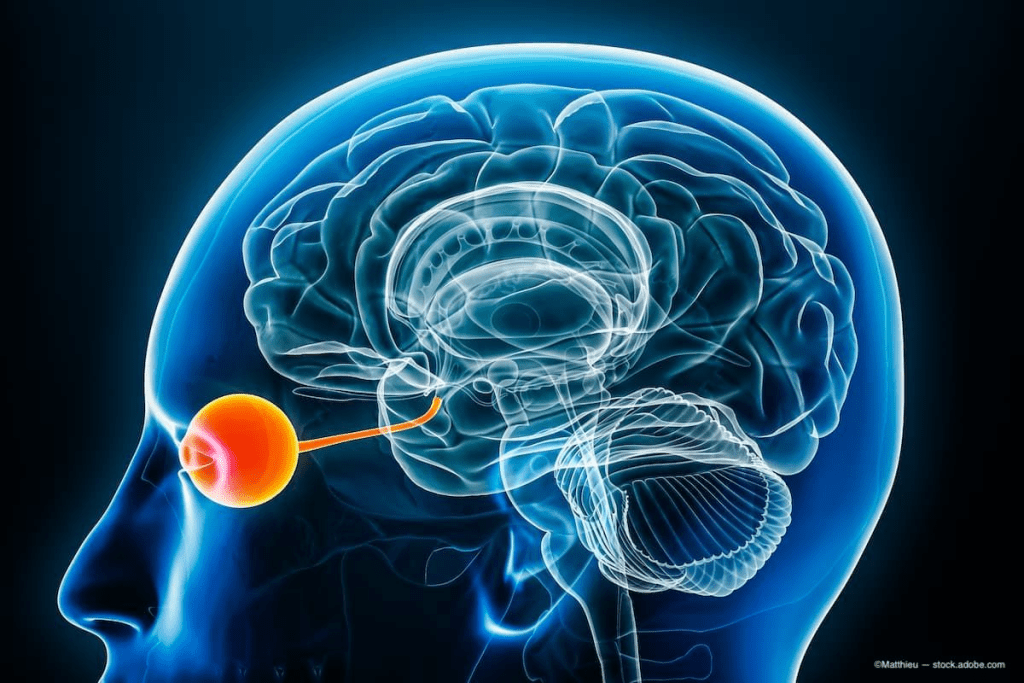Last Updated on November 14, 2025 by
Pediatric Chiari malformation is a birth defect. It happens when the cerebellar tonsils move into the spinal canal. This is due to a skull shape issue or it being smaller than usual.

Pediatric Chiari can be a complex issue, often seen at birth. It may cause different symptoms and problems. For more details, check out Children’s Hospital. They offer deep insights into the condition, how to diagnose it, and treatment options.
It’s important to understand Chiari malformation in kids for early treatment. This condition affects the cerebellum, which controls balance and coordination. We’ll look into what it means for children.
Chiari malformation happens when the cerebellar tonsils go into the spinal canal. This blocks the flow of cerebrospinal fluid. It can cause neurological symptoms. Often, it’s present at birth and can be linked to other brain issues.
Chiari 1 malformation is the most common. It happens when the cerebellar tonsils go into the upper spinal canal. This can cause headaches and neck pain by putting pressure on the brain and spinal cord.

The key sign of Chiari malformation is when the cerebellar tonsils extend into the spinal canal. This can block the flow of cerebrospinal fluid. It can lead to increased pressure in the skull and neurological symptoms.
In kids, Chiari malformation can show up differently than in adults. Some kids might not show symptoms, while others might have big problems. Finding it early is key to managing it well.
About 1 in 100 kids has Chiari type 1 malformation. Many don’t show symptoms until later in life. Symptoms can appear in late childhood or adulthood as the skull and brain grow.
It’s key to know how common Chiari malformation is in kids for early treatment. This condition affects many children worldwide, making diagnosis and care tricky.
About 1 in 100 kids might have Chiari type I malformation, but not all show signs. This shows why knowing about it and getting the right diagnosis is so important.
Only 10% of kids with Chiari type I malformation show symptoms like headaches or neck pain. Most kids with this condition don’t show any signs, which means they need careful checks and watchful waiting.

Knowing the difference between kids who show symptoms and those who don’t is key. Kids who show symptoms face many challenges, like:
An expert said, “Early recognition and proper care for Chiari malformation can greatly improve a child’s life.” This shows how vital early diagnosis and treatment are.
We know every child is different, needing their own care plan. By understanding Pediatric Chiari malformation, we can help families and doctors deal with this complex issue better.
Chiari malformations are divided into three main types, each with its own level of severity. Knowing these types helps doctors find the right treatment for kids with this condition.
Type I Chiari malformation is common in kids and adults. It happens when the cerebellar tonsils extend into the spinal canal. This can block the flow of cerebrospinal fluid (CSF).
This blockage can cause headaches, neck pain, and neurological problems. Early diagnosis is critical to avoid lasting brain damage.
Type II and III Chiari malformations are rarer and more serious than Type I. Type II, also known as Arnold Chiari syndrome, often comes with spina bifida called myelomeningocele. This is when the spinal cord and its membranes bulge out through a spinal opening.
Type III is the most severe and has a high risk of early death due to major structural problems.
It’s essential to note that Type II and III Chiari malformations often come with other birth defects. These can make treatment more complicated.
Children with Type II and III Chiari malformations often have other birth defects. These can include hydrocephalus, syringomyelia, and spinal deformities. These conditions can greatly affect a child’s life and need careful management.
Surgical intervention is often needed to treat these complex conditions and improve the child’s life.
The presence of these birth defects shows the need for a team approach to treating Chiari malformations. Specialists like neurosurgeons, orthopedic surgeons, and rehabilitation experts must work together for the best care.
It’s important to know the symptoms of Pediatric Chiari early. This helps in getting the right treatment. Kids with Chiari malformation face many symptoms that affect their life a lot.
Headaches and neck pain are common symptoms. These can get worse when kids do activities that raise pressure inside their heads. It’s key to spot these signs to tell them apart from usual kid problems.
Neurological problems can show up as numbness or weakness in the hands and feet. In bad cases, kids might even lose control of their muscles. Spotting these signs early is critical for quick help.
Kids with Chiari malformation often have trouble balancing and coordinating. This makes it hard for them to do everyday tasks or play sports. The problem comes from the brain’s part pushing into the spinal canal.
Many kids with Chiari malformation also have vision and hearing issues. They might see blurry, have double vision, or hear less. These issues can really hurt a kid’s school and social life.
In summary, the symptoms of Pediatric Chiari malformation are many and can really change a child’s life. Spotting these symptoms early is key to better treatment and outcomes.
It’s key to know the complications and related conditions of Pediatric Chiari malformation. This is to give full care to children. They face many secondary health problems that can really affect their quality.
Sleep apnea is a big worry for kids with Chiari malformation. Studies show it affects up to 22% of them. It means they stop breathing for short times while sleeping, which can harm their sleep and oxygen levels.
It’s very important to watch for sleep apnea. This is to stop long-term problems like delays in growth and brain issues.
Scoliosis, or a curved spine, can happen in up to 80% of kids with Chiari malformation. This is more common in those with spinal cord cysts. Spotting scoliosis early is key to avoiding serious spinal problems and managing other issues well.
Spinal cord cysts, like hydromyelia, make things even harder. They need careful watching and might need surgery.
Hydromyelia and syringomyelia are conditions in which fluid-filled cavities form in the spinal cord. These can cause serious brain damage if not treated. Regular scans are a must to catch these problems early. This way, we can act fast to stop brain damage.
We stress the need for a team effort in handling Pediatric Chiari malformation’s complications. Knowing these risks and using the right care can really help kids get better.
Early diagnosis is key to managing Pediatric Chiari malformation effectively. We understand that diagnosing this condition involves a multi-faceted approach. This includes clinical evaluation and advanced diagnostic imaging.
Diagnosing Chiari malformation in children starts with a thorough medical history and physical examination. Diagnostic imaging plays a critical role in confirming the diagnosis. We use MRI and CT scans to see the brain and spinal cord structures.
These tests help us understand how far the cerebellar tonsil has herniated. They also help identify any complications.
The choice of imaging modality depends on the clinical presentation. MRI is great for soft tissue images, like the brain and spinal cord.
Recent genetic research has shown that Chiari malformation may have a genetic basis. Studies have found genes linked to abnormal brain development. This may increase the risk in families.
Understanding these genetic factors helps us counsel families better. It also guides treatment decisions.
Treatment for Pediatric Chiari malformation varies based on the child’s needs. Non-surgical approaches include monitoring, pain management, and physical therapy. For severe symptoms or complications, surgical decompression may be needed.
We work with families to find the best treatment plan. We consider the severity of symptoms, associated conditions, and the child’s health.
Understanding Pediatric Chiari malformation is key to helping children get the right care. With the right diagnosis and treatment, kids with Chiari can live happy lives.
The outlook for kids with Chiari depends on how severe it is and how well treatment works. Early diagnosis and imaging are vital for finding the best treatment, which might be surgery or other methods.
Managing Chiari malformation in kids needs a lot of care and support. Knowing about the condition helps families deal with its challenges. This way, they can make their children’s lives better.
We stress the need for a team effort in treating Chiari malformation. This ensures kids get all the medical help and support they need to do well.
Pediatric Chiari malformation is a birth defect. It happens when the cerebellar tonsils go into the spinal canal. This can lead to many neurological problems.
Symptoms include headaches and neck pain. Children may also have trouble balancing and have vision or hearing issues.
Doctors use MRI scans to see the cerebellar tonsils and spinal canal. This helps them diagnose the condition.
There are three main types: Type I, II, and III. Type I is the most common in kids. Types II and III are more serious.
Complications include sleep apnea and scoliosis. Children may also have spinal cord cysts and other issues. This shows why they need careful care and monitoring.
The exact cause is not known. But, genetics might play a role. Family history can also be important.
Treatment depends on the symptoms and complications. It can be surgery or other methods. Sometimes, treating other conditions is also needed.
Yes, many kids with Type I Chiari malformation don’t show symptoms. This is why regular check-ups are key.
About 1 in 100 kids might have Chiari malformation. But, not all have symptoms.
The outlook depends on how severe the condition is and how well treatment works. Each child needs a personalized care plan.
Subscribe to our e-newsletter to stay informed about the latest innovations in the world of health and exclusive offers!